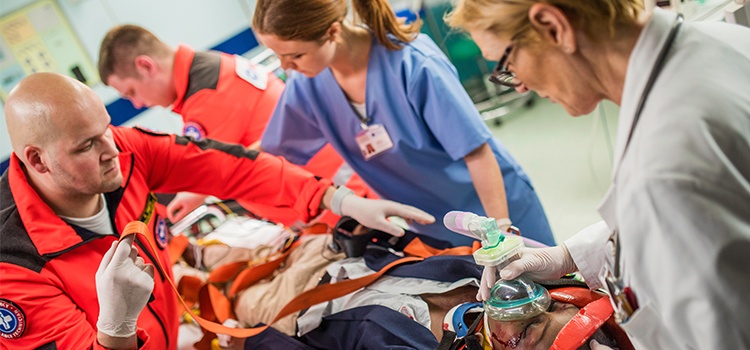Registered Nurse Career and Degree Guide
- Registered Nurse Overview
- Duties
- Salary
- Education
- LPN-to-RN Programs
- Paramedic-to-RN Programs
- Continuing Education for Nurses
Related Reading
How Can a Paramedic Become an RN?

Even though paramedics and registered nurses (RNs) have very different careers, their training and job duties may be similar enough that the progression from paramedic to RN is an educational pathway often pursued by those seeking a step up in their healthcare career. Earning an Associate Degree in Nursing (ADN) or a Bachelor of Science in Nursing (BSN) through a bridge program are two ways paramedics can become RNs.
In this Article
Paramedics don’t have nursing experience, but they do have experience providing patient care and treatment in emergency situations. Additionally, paramedics are licensed and required to complete formal healthcare education programs. This can provide the background for a great nursing career. It may also be a smart career move for many paramedics.
“Primary reasons paramedics seek to advance their careers and become RNs include increased monetary compensation, and the opportunity to explore other healthcare avenues such as critical care and emergency medicine,” says Amanda Dawson, RN, MSN-Ed, the Paramedic to RN Program coordinator at Stark State College in North Canton, Ohio.
Paramedic-to-RN Pathways
You’ve already completed at least 1,200 hours of formal medical education if you’re currently working as a paramedic. Your paramedic program likely covered broad topics such as anatomy and physiology, pharmacology, medical terminology and biology, as well as the skills to perform life-saving medical care. That education was on top of the initial courses you took to earn your Emergency Medical Technician (EMT) professional certification, the first step toward paramedic licensure in most states. Luckily, if you’re interested in becoming an RN, you may be able to use your paramedic education as the foundation for an RN degree.
Paramedics have two RN degree options:
Either degree will allow you to earn RN licensure and begin working. Generally, an ADN takes two years and a BSN takes four. However, students in paramedic-to-RN bridge programs are often able to complete their degrees much faster.
Bridge programs aren’t uncommon in the field of nursing. People who have some nursing education can often enter a program that will allow them to advance without repeating credits and training they already have. The LPN-to-RN bridge program is a good example of this: Those who are already licensed practical nurses (LPNs) can earn either an ADN or a BSN to become an RN at an accelerated pace.
No matter which educational path you choose, bridge programs are designed to build on the healthcare education you already have, and on the real-world skills you use every day. Bridge programs will expand on your existing knowledge with courses in topics such as nursing theory or care planning.
“The prior knowledge of a paramedic allows their transition from paramedic to RN to be a much smoother process than it often is for our more traditional nursing students,” says Dawson.
Paramedic-to-ADN Bridge Program
These programs are typically designed and structured with paramedics who are currently working in mind. There might be options for part-time schedules, online courses, or for night and weekend classes.
“Paramedics can still work while attending our program, as our requirement is only onsite two days a week,” says Dawson. “The curriculum is completed in three semesters.” She also says that ADN programs are a great fit for students looking to earn their degrees fast and save money.
“An associate degree program graduate takes the same NCLEX (nursing license exam) at the end of the program as the BSN graduate,” Dawson says. “The main difference is our students complete the workload in half the time and for a fraction of the cost.”
Paramedic-to-BSN Bridge Program
A paramedic-to-BSN bridge program is a good fit for students who are looking to earn a bachelor’s degree and pursue advanced career paths. While both ADN and BSN graduates are able to earn RN licensure, there are some specific RN roles, job titles, and even employers that do require a BSN. For instance, if a career goal of yours is to be a nurse case manager at a medical facility, a paramedic-to-BSN bridge is probably a better fit for you than a paramedic-to-ADN bridge.
Can I earn my degree online?
Many schools offer online paramedic-to-RN bridge programs. You’ll be able to take your courses online when you choose one of these programs. This allows you to work at your own pace and might allow you to earn your degree faster.
However, all nursing degrees do have clinical experience requirements. That means that even if you take all your classes online, you will need to complete formal clinical hours in person. Your school will likely help you set up clinical work at a local facility.
Why Would a Paramedic Want to be a Nurse?
Paramedics are key players in the healthcare field. They respond to emergency situations and provide all of the medical care that a patient needs before they arrive at a hospital. This includes:
RNs also provide patient care and need to master every skill paramedics already have. So, for a paramedic looking to advance their education and career, nursing is a natural choice.
The expanded duties and opportunities, along with the potential for a significant bump in salary, make this career move appealing to many paramedics. Plus, it’s a great way to change careers by building on your current role and experience.
The expanded duties and opportunities, along with the potential for a significant bump in salary, make this career move appealing to many paramedics.
“Paramedics already have a background in critical care, trauma, and some RN skills,” says Dawson. “They are quick learners and fast-acting (in) patient scenarios.”
Paramedic vs RN Responsibilities
Initial Assessment Responsibilities:
Paramedic:
Assessing patients
RN:
Assessing patients and creating a care plan for their stay; recording all data in their patient record
Patient Care Responsibilities:
Paramedic:
Performing CPR and other emergency life-saving procedures
RN:
Ensuring patients are safe, comfortable, and in as little pain as possible during their hospital stay
Pharmaceutical Responsibilities:
Paramedic:
Administering emergency medications
RN:
Administering emergency, temporary, and routine medications
IV Responsibilities:
Paramedic:
Administering IV saline, nasal oxygen, and other emergency treatments
RN:
Administering IV fluids or breathing treatments
Emergency Patient Care Responsibilities:
Paramedic:
Stabilizing patients for a move to the hospital
RN:
Taking action if a patient’s condition declines
Patient Monitoring Responsibilities:
Paramedic:
Monitoring and recording vitals
RN:
Monitoring vital signs, skin quality, pain, symptoms, and more during the patient stay; keeping detailed patient records
Wound Care Responsibilities:
Paramedic:
Treating wounds and other injuries
RN:
Performing wound care and other treatments as needed and ordered by a doctor or nurse practitioner
Popular Nursing Jobs for Former Paramedics
Paramedics respond to a wide variety of emergency situations, such as heart attacks, strokes, anaphylaxis, car accidents, in-home accidents, and violent crime. This experience can translate to a variety of nursing specialties. Some specialties, such as emergency room nursing, trauma nursing, or operation room nursing, draw on many of the same skills as paramedic work and are especially popular with former paramedics.
“Paramedics generally gravitate towards the emergency department or critical care intensive units,” says Dawson. “Some will consider medical-surgical or surgery as well.”
Operating Room (OR) Nurse
About the Job:
OR nurses help care for patients before, during, and after surgery. They assist with surgery and pain management.
Why It’s a Good Fit:
Paramedics have experience with pain management and with keeping patients calm. Additionally, they are unlikely to be squeamish about surgical procedures.
Acute Care Nurse
About the Job:
Acute care nurses help stabilize patients who are experiencing an acute injury or illness.
Why It’s a Good Fit:
The calls that paramedics respond to are almost always for acute and sudden injury and illness.
Emergency Room (ER) Nurse
About the Job:
ER nurses assess and treat patients as they come into the emergency room, providing emergency care as part of a team.
Why It’s a Good Fit:
Patients who come into the ER are generally experiencing symptoms similar to people who call 911 and are treated by paramedics. Often, paramedics bring patients to the ER.
Trauma Nurse
About the Job:
Trauma nurses care for injured patients. This might include wound care, pain management, stabilizing injuries, and more.
Why It’s a Good Fit:
Trauma unit RNs generally care for people with injuries sustained in car accidents, home accidents, crimes, and other incidents paramedics often respond to.
Critical Care Nurse
About the Job:
Critical care nurses provide care for patients who need close monitoring due to injury or illness.
Why It’s a Good Fit:
Paramedics have experience reading cardiac monitors and other vitals while transporting patients.
Labor and Delivery Nurse
About the Job:
Labor and delivery nurses assist obstetricians or midwives during childbirth and provide care both before and after the baby is born.
Why It’s a Good Fit:
Paramedics sometimes deliver babies when mothers are unable to make it to the hospital or planned birthing location in time.
Psychiatric Nurse
About the Job:
Psychiatric nurses care for patients in mental health facilities who are being treated for a range of conditions.
Why It’s a Good Fit:
Paramedics respond frequently to calls from patients experiencing mental health crises.
Paramedic vs RN Salary
Paramedics who become nurses may see a sizable jump in salary, although salaries will depend on experience, education, employer and location. According to the U.S. Bureau of Labor Statistics (BLS), paramedics (which are classified together with EMTs) earn a median salary of $53,180. The top 10% of paramedics may earn a median salary of $79,430, which is slightly less than an RN’s median salary of $86,070.
Choosing the right paramedic-to-RN bridge
Figuring out which bridge program is best for you begins with understanding your own needs, limitations and desires for your education.
Do Paramedics Make Good Nurses?
Paramedics have the potential to make excellent nurses. Many of the skills and traits needed to be a successful paramedic can also help you succeed as a nurse. Additionally, the experience gained as a paramedic can be used in daily nursing practice.
Paramedics can make great nurses because they:
“Paramedics make great RN’s when given the correct education pathway,” says Dawson.
FAQ: Frequently Asked Questions
Yes, but there are no bridge programs for basic Emergency Medical Technicians (EMTs) to advance directly to an RN. Since EMT’s receive less training than paramedics, they have more to learn in order to become an RN when compared to paramedics.
Some programs are called EMT-P-to-RN bridge programs, which are intended for EMTs that have already become paramedics. Basic EMTs that wish to transition directly to an RN should enroll in an ASN, BSN or ABSN program. Depending on the program, they may be able to receive credit for the training they already received to become an EMT.
Yes, there are RN-to-paramedic bridge programs available. It is common for these bridge programs to require that incoming nurses already have an EMT certification, have worked as RNs for a certain number of years and/or for a certain number of hours in an emergency or critical care setting. The exact length of the program can vary depending on your existing RN experience.


With professional insight from:
Paramedic to RN Program Coordinator, Stark State College
